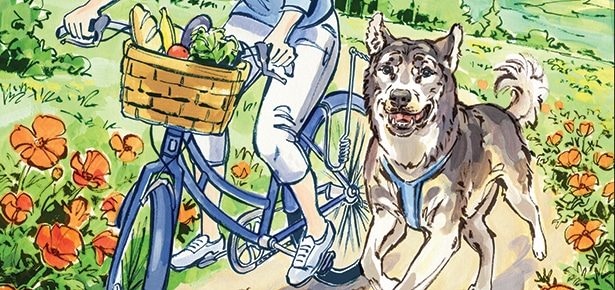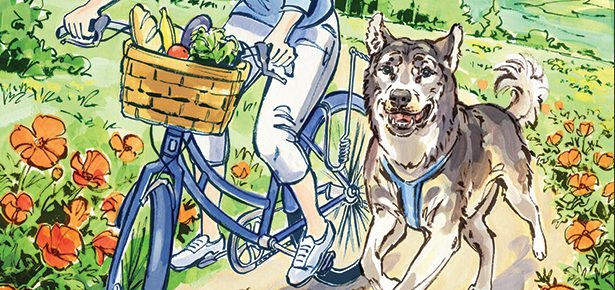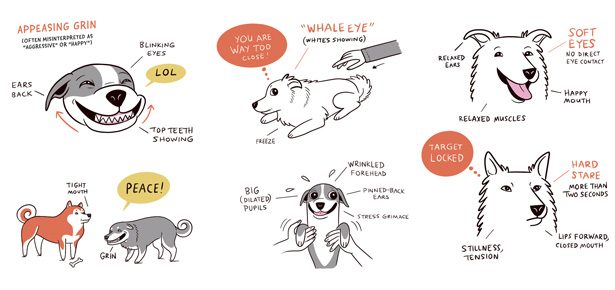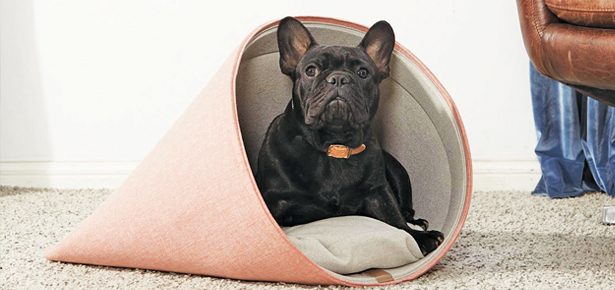

Dog Biking for Beginners
Save time + give your dog the exercise he needs: Go for a bike ride with your dog instead of a long walk!
Timber, trotting happily beside the bike, glances up at me. He is giving me a look I know well, a look that says, “I want to run!” In response, I start to pedal faster and say, “Let’s go!” As we approach a long, flat section of the bike path, Timber increases his stride, his long legs stretching into a graceful lope. His face breaks out into an enormous smile: an expression of complete pleasure. A grin starts to curl up on my face as well; seeing Timber so full of joy, I can only feel that way myself.
Learning how to bike with Timber has been a blessing. A Husky/Malamute cross, he is a strong and powerful dog. Like many high-energy dogs, a walk was simply not enough of a workout for him. For Timber, a Northern dog bred to pull a sled for long distances over snow-covered terrain, a walk was only a warm-up. What Timber wanted and needed was to run. Taking him for a bike ride set him free: beside the bike, he could run like the wind.
Biking with Timber instead of taking him for a walk had another huge advantage. Since trotting beside a bike is much more strenuous for a dog than walking, cycling gave my sturdy Malamute a much better workout in a much shorter time. I could take him for a half-hour bike ride and then he would be content to head home, put his paws up and take a snooze.
Best breeds for biking
Could dog biking work for you? This sport is ideal for dogs with plenty of energy such as the Border Collie and Siberian Husky. Smaller, lively dogs such as the Jack Russell Terrier can also make enthusiastic cycling partners. Of course, your dog doesn’t have to be a purebred to benefit from biking. Any mutt who has lots of get-up-and go can enjoy the sport.
Aside from energy level, age is a factor in determining whether biking is a fitting activity for your pooch. Puppies and juvenile dogs—particularly large or giant breeds—must wait until their musculoskeletal development is complete before running beside a bike because the impact can injure their delicate growing bones and joints. This generally occurs at about the age of two for large dogs and around 18 months for most medium and small dogs. And senior canines who lack enthusiasm for vigorous activity or suffer from degenerative joint diseases such as arthritis will take more pleasure from a gentle walk than a strenuous bike ride. Check with your vet to see if she thinks cycling is appropriate for your pooch.
But is it dangerous? Will my dog pull me off my bike?
Once your vet gives you a “paws up,” the next step is to find a dog-biking leash that works for you and your favourite canine. These devices are different from regular dog walking leashes; they are designed to keep your dog at the side or slightly behind your bike, enabling you to keep both hands on the handlebars and maintain control of the ride. Most of these special leashes also have a mechanism such as a coil spring that absorbs much of the shock if something suddenly catches your dog’s interest and he gives the leash a tug. There are many dog biking leashes out on the market and which one is best for you and your dog really depends on your needs. Is your dog large or small? Will he trot obediently along beside you or try to chase every leaf that blows across his path? Do you need a leash with great shock absorption or will a basic dog biking leash work for you? I’ve tried both the Springer bike attachment (springeramerica.com) and the Bike Tow Leash (biketowleash.com) and both of them worked well for my large, powerful dogs.
Familiarizing your dog with biking
Once you obtain your dog biking leash, give your pooch a chance to become familiar with it. Attach the leash to your bike and let him give it a thorough sniff. Once he becomes accustomed to seeing the leash on your bike, fasten him to it and take him for a short walk while he is attached to the bike. Since dogs sense people’s emotions, stay relaxed and act as though this walk is just the same as any other walk.
When your dog is comfortable walking beside the bike, get on the bike and start pedalling slowly but steadily, ideally in an area with little car traffic. This will encourage your dog to increase his pace to a fast walk or easy trot. As your dog jogs along beside you, praise him for being such a good cycling partner. Avoid making any sudden movements that might spook your dog and cause him to fear the bike. If you turn, make it wide.
Continue cycling in this way for a short time, perhaps 10 or 15 minutes, and then make your way back towards where you started. Slow down, get off your bike and walk your dog back the last little way. When you unfasten him from the bike, praise your pooch for being such a good dog. Do not drop your bike or make any harsh clanging noises with it that might jar your dog.
This simple routine—a walk to warm up, a trot alongside the bike, and then a walk to cool down—is the basis of your dog biking program. As you both become more familiar with biking, you can go for longer rides (my energetic Malamute Timber can handle 30 minutes, max) but do it gradually and take a day off to rest between rides. Remember that your bike allows you to cruise along without much effort; your dog, on the other hand, cannot coast. He must work to keep up with you on the bike so you need to pedal at a pace that is comfortable for him. For most of the ride, pedal at a speed that enables your dog to travel at a fast walk or leisurely trot—this is likely a fair bit slower than you are used to pedalling so mind that your speed doesn’t creep up. Keep an eye on your dog at all times to ensure he is jogging along without any strain or struggle. If your dog shows any sign of tiredness or lack of enthusiasm—his head drops down, he begins to pant heavily, he starts to drag his paws—stop pedalling, get off the bike and walk for awhile. Stop from time to time to give him a chance to take a sniff or sip some water.
If you start your dog-biking program in the summer, go early in the morning or late in the evening when it is cool since it is easy for your dog to overheat. Choose paw-friendly surfaces to ride on such as an old dirt road, grassy field or earthen bike path—a dark asphalt road can become quite toasty on sizzling summer days and scorch your dog’s pads. Explore quiet residential areas with little motor vehicle traffic instead of congested, smoggy streets.
Working as a team
As you and your dog get more accustomed to biking, you can start training him in directional commands. For example, when you want to slow down, say “easy” while gently applying the brakes and then say “whoa” as you come to a complete stop. As your dog learns what you want him to do, he will become more confident and you will work together as a team. For me, this is one of the most rewarding aspects of biking with my dog; it does not involve me taking my dog for a ride; it is the two of us, working in harmony, savoring every second of our shared experience.
J. Leslie Johnson is the author of Bike With Your Dog: How to Stay Safe and Have Fun. This comprehensive guide tells you everything you need to know about dog-biking from conditioning your dog to the special challenges of cycling in winter. Check it out a friesenpress.com/bookstore.
Join the newsletter and never miss out on dog content again!
"*" indicates required fields
By clicking the arrow, you agree to our web Terms of Use and Privacy & Cookie Policy. Easy unsubscribe links are provided in every email.





